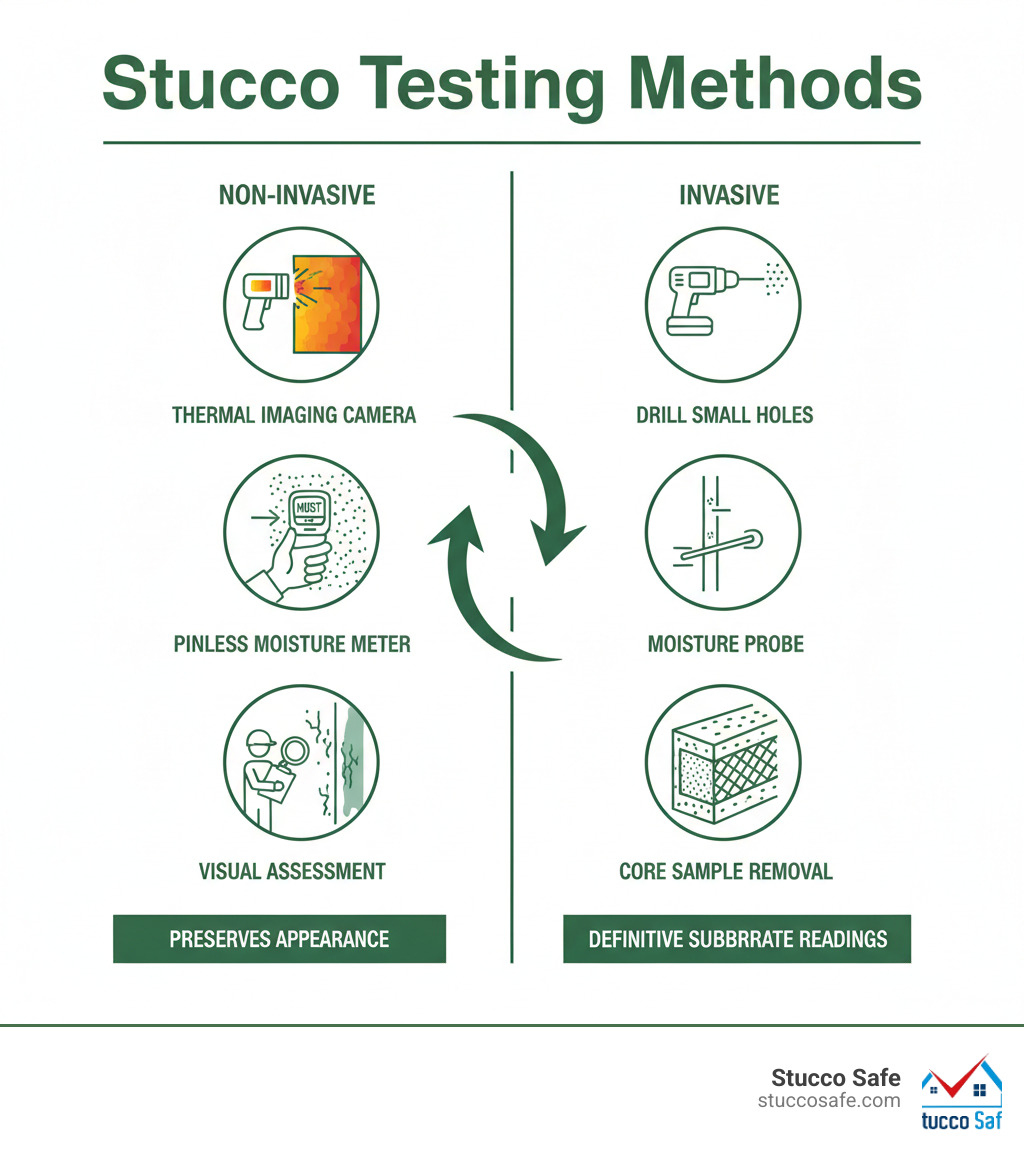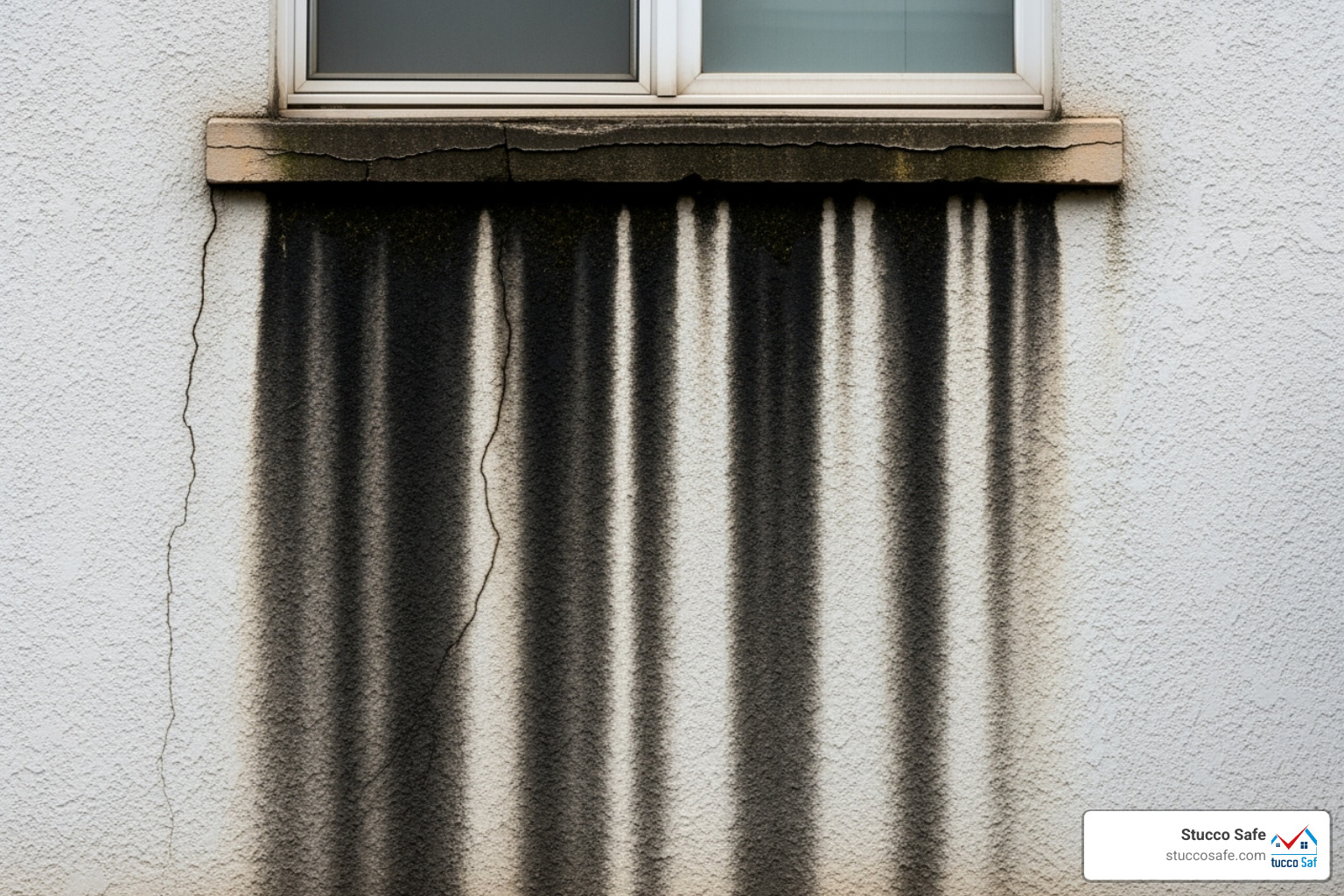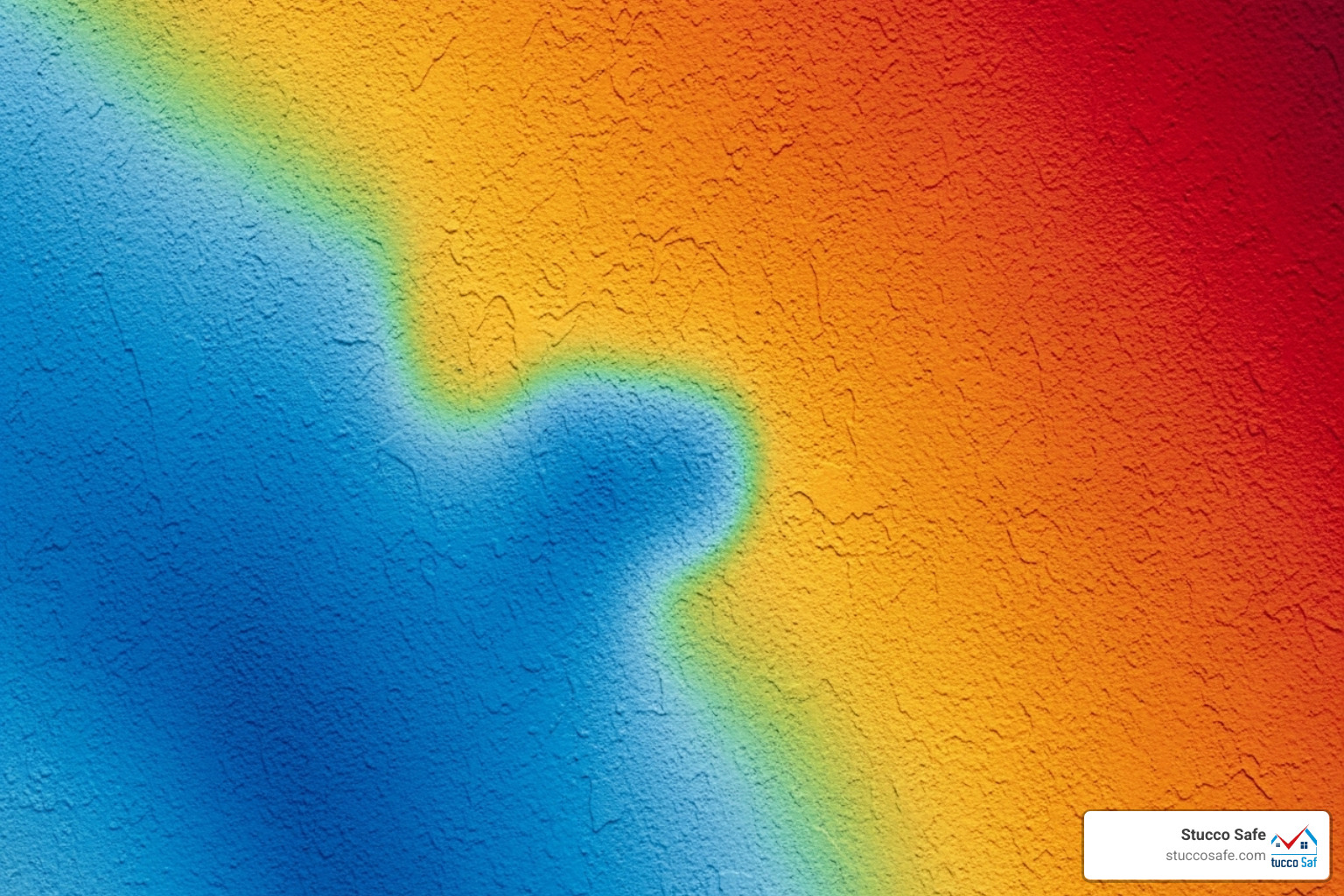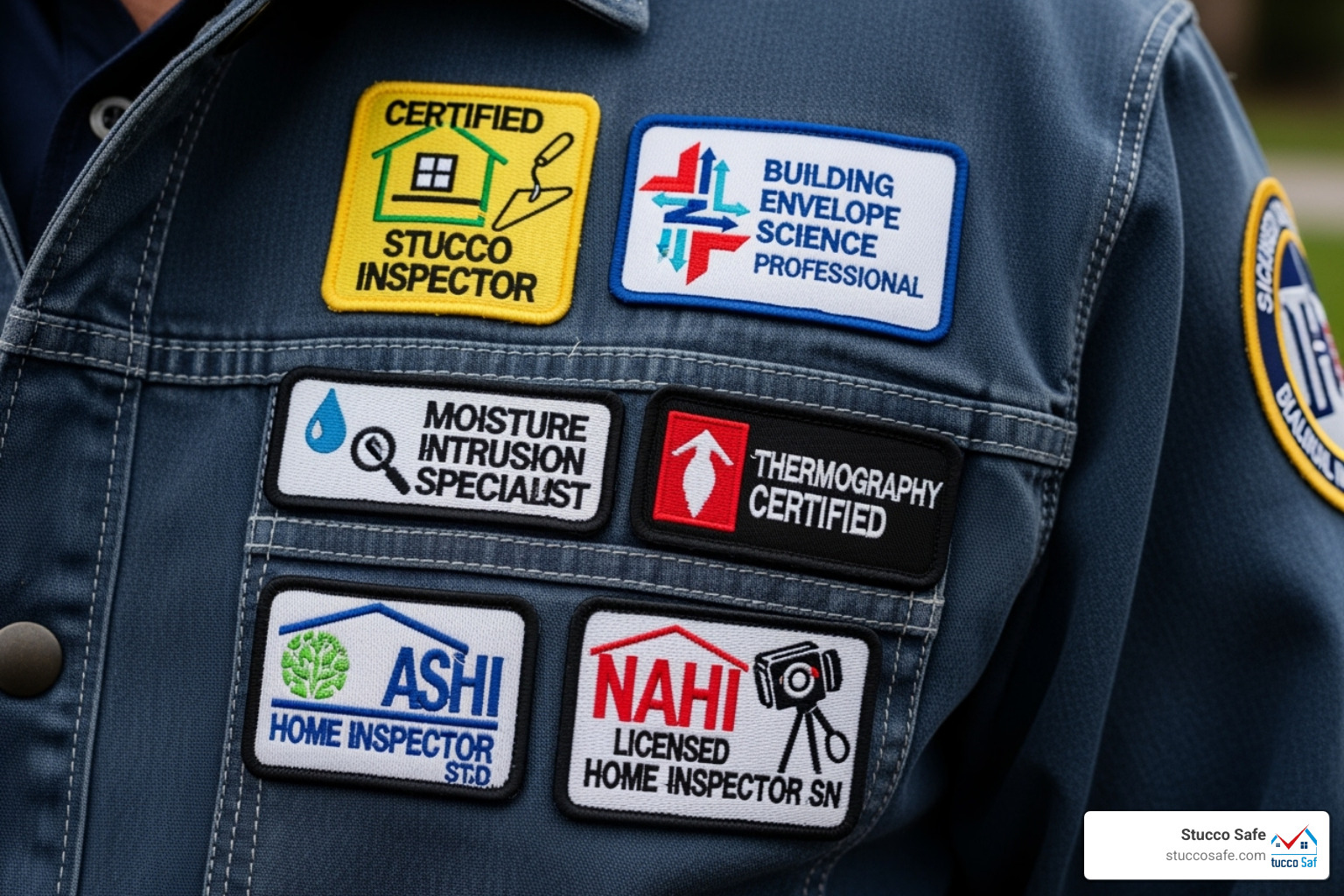Non Invasive Stucco Testing: 1 Essential Guide
Seeing Beneath the Surface Without a Scratch
Non invasive stucco testing is a method of assessing your home’s stucco exterior for moisture issues and structural problems without drilling holes or damaging the surface. Here’s what you need to know:
Key Methods:
- Thermal Imaging – Infrared cameras detect temperature differences that may indicate moisture
- Electronic Moisture Meters – Pinless scanners measure surface moisture levels up to 3/4″ to 1″ deep
- Visual Assessment – Trained inspectors examine flashing, weep screeds, cracks, and staining patterns
Typical Cost: $495 to $1,595+ depending on home size
When You Need It:
- Every 2-4 years for preventive maintenance
- Before buying or selling a stucco home
- After noticing stains, cracks, or efflorescence
- Following severe weather events
If you’re worried about what’s lurking behind your stucco, you’re not alone. Hidden moisture can cause costly wood rot, mold, and structural damage. The good news is that you don’t need to drill holes to find out what’s happening. Think of non-invasive stucco testing like a dental x-ray; it allows a certified inspector to spot problems without puncturing your home’s exterior, preserving its appearance and integrity.
The stakes are high, as over 80% of stucco applications in many regions have been improperly installed, particularly on homes built between 1980 and 2021. Non-invasive testing is a stress-free starting point that reveals trouble spots without creating new entry points for water. If concerns arise, targeted invasive testing can be recommended only where necessary.
I’m Gabe Kesslick, an EDI Level 2 Certified Stucco Inspector and Building Envelope Forensic Inspector specializing in leak detection since 2001. I use non invasive stucco testing to provide homeowners with critical insights without compromising their home’s exterior.
The “Why”: Key Reasons to Schedule a Non-Invasive Stucco Inspection
If your home has stucco, there’s a good chance something isn’t right behind the walls. A sobering fact: more than 80% of stucco applications in many regions have been improperly installed, especially on homes built between 1980 and 2021. Water can seep in quietly, and by the time you notice a problem, you could be facing tens of thousands of dollars in repairs for wood rot, mold, and structural damage. Non invasive stucco testing is your early warning system, catching problems while they’re still manageable.
Proactive Protection for Your Biggest Investment
Your home is your biggest asset and deserves preventive care. We recommend a non invasive stucco testing every 2-4 years. In Southeastern Pennsylvania, New Jersey, and Delaware, our homes face heavy rain, high humidity, and brutal freeze-thaw cycles that turn tiny cracks into major water entry points. Regular inspections help catch wood rot and mold growth early, saving you from a crisis. A small repair now costs hundreds, not tens of thousands later.
Critical Due Diligence in Real Estate
Buying or selling a stucco home? A non invasive stucco testing is essential. For buyers, it’s a safety net against finding $40,000 of hidden damage after closing. An inspection provides negotiation leverage to request repairs, credits, or walk away. For sellers, a pre-listing inspection offers control. You can address issues upfront or price accordingly, leading to smoother negotiations and fewer deals falling apart.
Telltale Signs Your Stucco is Crying for Help
Your home leaves clues when something is wrong. Spotting these signs can save you from catastrophic damage.
- Dark staining patterns: Discoloration below windows or near the foundation indicates water is getting where it shouldn’t.
- Cracking: Hairline cracks are entry points for water, while larger patterns can signal structural movement or serious moisture damage.
- Efflorescence: This white, chalky powder is a distress signal. It’s mineral salts left behind as trapped moisture evaporates through the stucco.
- Bulging or delamination: If stucco is bubbling or separating from the wall, it means trapped moisture is causing serious damage underneath.
- Missing or buried weep screeds: These components are vital for drainage. If they’re absent or buried under landscaping, water gets trapped in your walls.
- Failing caulk: Cracked, shrunken, or missing caulk around windows and doors is an open invitation for water.
These are not cosmetic issues; they are symptoms of worsening problems. If you spot them, it’s time to schedule a non-invasive stucco inspection to find out what’s really happening.
The Inspector’s Toolkit: Technology Used in Non-Invasive Stucco Testing
Our non invasive stucco testing approach combines cutting-edge technology with expert detective work. We use specialized instruments to take your home’s vital signs, then apply our expertise in building envelope science to interpret the results. This strategy helps us identify potential problems without putting a single hole in your walls. You can learn more about our complete approach at Stucco Safe’s Stucco Inspection Services.
Thermal Imaging: Detecting Temperature Clues
Think of thermal imaging as X-ray vision for temperature. Our infrared (IR) cameras detect temperature variations on your home’s surface. When moisture accumulates behind stucco, it causes those areas to appear cooler on our thermal images due to evaporation and the higher thermal mass of wet materials. These temperature differentials can also reveal missing insulation or delaminating stucco.
A common myth is that thermal cameras “see” water directly. They don’t. They detect temperature patterns that suggest moisture. That’s why an experienced inspector is critical to interpret the images correctly and distinguish a potential leak from a harmless anomaly.
Electronic Moisture Meters: Scanning for Surface Moisture
The second tool in our non invasive stucco testing arsenal is the electronic pinless moisture meter. We use professional-grade equipment like the Tramex Moisture Encounter Plus to scan your stucco surface without making holes. These meters detect moisture levels up to 3/4″ to 1″ deep.
We systematically scan your home’s exterior, focusing on high-risk areas like windows and doors. The meter provides real-time readings that help map out zones where moisture might be lurking. It’s important to know their limitations: they can’t always reach the wood sheathing behind thick stucco, and the metal lath in traditional stucco can sometimes interfere with readings, causing false positives. A trained inspector understands how to interpret these readings in context.
The Visual Assessment: An Expert’s Most Powerful Tool
Even with advanced gadgets, the most powerful tool is the trained human eye. Our visual assessment is where the real detective work happens. We examine:
- Flashing details: Especially kickout flashing where roofs meet walls, a common failure point.
- Window and door seals: Checking caulk integrity around these moisture entry points.
- Weep screeds and control joints: Ensuring these critical components are present and properly installed.
- System identification: Determining if you have traditional hard coat stucco or synthetic EIFS, as each has unique vulnerabilities.
We combine these visual observations with our thermal and moisture meter data to build a complete, accurate picture of your stucco system’s health. This forensic approach is what makes non invasive stucco testing so powerful.
The Process, The Report, and The Next Steps
So you’ve scheduled a non invasive stucco testing – what happens now? A typical inspection takes 1-3 hours, depending on your home’s size and complexity, with costs ranging from $495 to $1,595 or more for very large properties. At the end, you’ll receive a roadmap with actionable recommendations to protect your investment.
What to Expect During a Non-Invasive Stucco Testing Appointment
Our team follows a systematic process to examine every critical area without damaging your exterior.
- Exterior Walk-Around: We begin with a thorough visual assessment, documenting the overall condition of your stucco, window seals, flashing, and any visible distress like stains or cracks with photographs.
- Thermal Scanning: Using infrared cameras, we scan all walls to build a thermal map of your home, looking for temperature differences that may indicate hidden moisture.
- Moisture Meter Scanning: We use pinless electronic meters to check surface moisture levels, focusing on high-risk zones and areas flagged by the thermal scan.
- Drone Inspection: For hard-to-reach areas on multi-story homes, we deploy drones with high-definition cameras to ensure a complete inspection without the need for scaffolding.
Decoding Your Inspection Report
A few days after the inspection, you’ll receive a comprehensive report that translates our findings into clear, actionable information. Key sections include:
- System Identification: Clarifies whether you have traditional stucco or EIFS.
- Photographic Documentation: Extensive high-resolution images of our observations, with annotations on areas of concern.
- Thermal Imaging Results: Infrared images with our expert analysis explaining what the temperature patterns mean.
- Moisture Map: A detailed description of where we detected liftd surface moisture.
- Prioritized Recommendations: A clear, wall-by-wall breakdown of our findings and a practical action plan, prioritized by urgency.
From Results to Resolution: Your Action Plan
Receiving the report is the start of your action plan. The next steps depend on our findings.
- Clean Bill of Health: If your stucco is performing well, we’ll provide recommendations for preventive maintenance and suggest your next routine inspection in 2-4 years.
- Minor Issues: For problems like failing caulk or minor cracks, we’ll outline the specific maintenance tasks needed to prevent bigger issues. You can hire a trusted contractor to handle these straightforward fixes.
- Significant Concerns: If we find strong evidence of moisture intrusion, we will recommend targeted invasive testing. This involves taking small core samples only in the specific areas of concern to confirm what’s happening to the wood sheathing behind the stucco. This targeted approach minimizes damage while maximizing diagnostic accuracy.
Because Stucco Safe is an independent inspection company that doesn’t perform repairs, you can trust our recommendations are completely unbiased. Our only goal is to give you accurate information so you can make the best decisions for your home.
Choosing Your Stucco Detective: How to Hire a Qualified Inspector
Choosing the right person for your non invasive stucco testing is critical. You need an independent inspector—one who only performs inspections and does not also repair stucco. This eliminates any conflict of interest and ensures you receive an unbiased assessment. At Stucco Safe, we only inspect; we don’t do repairs, so our findings are always honest.
Local experience is also key. An inspector who understands the climate challenges of Southeastern Pennsylvania, New Jersey, and Delaware will recognize regional issues others might miss. Look for professionalism, clear communication, and respect for your property.
The Non-Negotiable Credentials
Not all inspectors are created equal. Look for proven expertise through certifications that show a mastery of building envelope science.
- EDI Level II Certification: This is the gold standard for stucco and EIFS inspectors.
- Other Key Credentials: Look for InterNACHI training, BESI Level 2 Certified Building Envelope Forensic Inspector, and certifications from organizations like the Moisture Free Warranty Corp.
- Insurance: The inspector must carry both professional and general liability insurance. Stucco Safe maintains professional liability coverage of at least $1 million to protect you and stand behind our work.
Questions to Ask Before You Hire
Before hiring, have a conversation and ask these key questions for your non invasive stucco testing:
- “Are you independent from repair contractors?” The answer must be an unequivocal “yes.”
- “Can I see a sample report?” A quality report should be clear, detailed, and actionable.
- “What are the limitations of your non-invasive inspection?” An honest inspector will explain that non-invasive testing is a screening tool and that invasive testing is sometimes needed for confirmation.
- “What specific equipment do you use?” They should mention infrared thermal cameras and pinless moisture meters.
- “How much experience do you have in this area?” Local experience in PA, NJ, or DE is invaluable.
Asking these questions will help you find a qualified professional who will give you the thorough, honest assessment your home deserves.
Frequently Asked Questions about Non-Invasive Stucco Testing
Here are answers to the most common questions we hear about non invasive stucco testing.
How accurate is a non-invasive stucco inspection?
A non invasive stucco testing is a highly valuable screening tool, but it is not a definitive diagnosis. It excels at identifying potential trouble spots where moisture may be lurking. However, it cannot see through walls to confirm damage in the substrate. The accuracy depends on the inspector’s skill, the quality of the equipment, and environmental conditions. If our non-invasive inspection reveals significant concerns, we will recommend targeted invasive testing to confirm the presence and extent of any damage, ensuring holes are drilled only where necessary.
Can commercial buildings benefit from this type of inspection?
Yes, absolutely. Non invasive stucco testing is ideal for commercial properties, including multi-story office buildings, retail centers, and apartment complexes. We adapt our approach for larger, more complex building envelopes, often using drones to safely inspect upper floors without expensive scaffolding. The process is non-disruptive, allowing tenants and businesses to operate normally while the building owner gets a thorough assessment that can prevent massive repair costs.
Who typically pays for a stucco inspection during a home sale?
Traditionally, the buyer pays for the stucco inspection as part of their due diligence. This allows them to get an independent assessment of the property they intend to purchase. However, a growing trend is for proactive sellers to invest in a pre-listing inspection. This gives them control, allowing them to address issues beforehand or price the home accordingly, which can lead to a smoother, faster sale. The cost can be a point of negotiation between the buyer and seller.
Conclusion: Protect Your Home with Confidence
Your home is your biggest investment and where you should feel most secure. Non invasive stucco testing is a smart, sensible first step to protect it, allowing you to catch problems early before they become expensive nightmares. No drilling, no damage—just clear answers and peace of mind.
At Stucco Safe, we provide unbiased, expert inspections you can trust. We don’t repair stucco, so our only goal is to give you an accurate assessment. Our certified inspectors use forensic-level expertise and cutting-edge technology across Southeastern Pennsylvania, New Jersey, and Delaware.
Don’t let hidden moisture turn your dream home into a source of stress. Knowledge is power, and homeowners who take action early always come out ahead. Take control today.
Stay connected with us for helpful tips and insights:
Ready to protect your investment? Schedule your non-invasive stucco inspection today and move forward with confidence.





